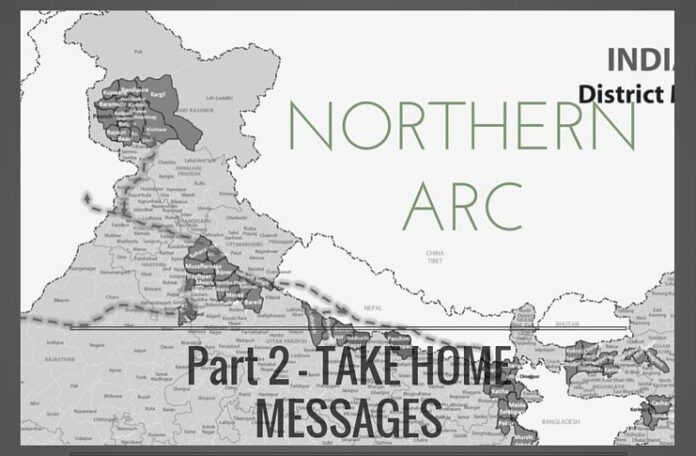
Part 1 of this series titled Hotspots in the Hindi Belt, Part 1 – the Northern Arc lays out the areas where demographics are changing rapidly in India. In this part, we discuss the take away messages.
Section B: Take Home Messages
Section B.1: Take Home Message 1: Shrinking Hindu Populations in hubs of Hindi Belt
[dropcap color=”#008040″ boxed=”yes” boxed_radius=”8px” class=”” id=””]W[/dropcap]e show using multiple statistical models that both the districts of Purnia and Santhal Parganas will become Hindu minority (or close to it). The Hindu population in the Santhal Parganas has been under a double attack, by a rapidly increasing Muslim population in the Sahebganj, Pakur and Godda regions and a swiftly rising Christian population everywhere in the districts except for Deoghar and Jamtara regions. Sahebganj and Pakur districts of the erstwhile Santhal Pargana will be Hindu minority soon. In Purnia, Kishanganj is already Hindu minority (31% Hindu) and Hindus in Ararea and Katihar are barely above the 50% mark (56% and 54% respectively). In the current Purnia district too, the Hindu population is falling sharply and the entire (old) Purnia is set to be Hindu minority by 2041. In Bahraich-Gonda composite district, Balrampur will be Hindu minority soon, while both Bahraich and Shravasti districts will be less than 60% Hindu. Similarly, in the Gurgaon, which is just South of Delhi, Mewat district is already less than 30% Hindu and the trend is set to accelerate in future, with tehsils of Faridabad becoming Hindu minority. In Gurgaon, the Hindu percentage has been falling despite huge influx of Hindu migrants from other parts of India from the 80s.
| Table 1: Actual Hindu population in 1951 and 2011 and the predicted Hindu populations in 2061 using the three methods | |||||
| District | Actual Hindu in Percentage (%) | Predicted Hindu Percentage (%) in 2061 using three methods | |||
| 1951 | 2011 | Constant Growth | Polynomial | Logistic | |
| Bahraich-Gonda | 78.90 | 70.72 | 65.61 | 66.56 | 65.41 |
| Purnia | 69.93 | 53.86 | 44.71 | 45.39 | 49.19 |
| Santhal Parganas | 90.39 | 73.01 | 41.48 | 52.69 | 60.14 |
| Gurgaon | 83.04 | 76.15 | 68.18 | 74.99 | 70.71 |
| Table 2: Year by which the districts will become Hindu minority, according to the different models | |||
| Districts | Constant Growth | Polynomial | Logistic |
| Bahraich-Gonda | – | – | – |
| Purnia | 2041 | 2041 | 2051 |
| Santhal Parganas | 2051 | – | – |
| Gurgaon | – | – | – |
[dropcap color=”#008040″ boxed=”yes” boxed_radius=”8px” class=”” id=””]T[/dropcap]he point in all the cases is that the Muslim population percentage is essentially nearly doubling in almost all the districts under consideration. We have depicted the projected changes in Abrahamic population since 1951 using the three models. The projected population of Christians in Santhal Parganas in the constant growth model is likely an overestimate. However, it is pertinent to remark that, in old Santhal Parganas, Muslims are tripling, and Christian percentage is rising 50-75 fold.
| Table 3: The percentage of Muslims and Christians (shown after the slash, where applicable) in the different districts for 1951 and the projected percentages in 2061 using the three mentioned techniques | ||||
| Districts | 1951 Population | Constant Growth | Polynomial | Logistic |
| Bahraich-Gonda | 21.09 (M) | 34.39 (M) | 33.43 (M) | 34.58 (M) |
| Purnia | 30.06 (M) | 55.08 (M) | 54.6 (M) | 50.8 (M) |
| Santhal Parganas | 9.43 (M) /0.17 (C) | 28.35 (M) /30.16 (C) | 35.09 (M) /12.21 (C) | 30.9 (M) /8.95 (C) |
| Gurgaon | 16.95 (M) | 31.81 (M) | 25 (M) | 29.25 (M) |
Section B.2: Take Home Message 2: The Mughalistan Corridor – Truth or Hype?
[dropcap color=”#008040″ boxed=”yes” boxed_radius=”8px” class=”” id=””]A[/dropcap] lot has been written on the Mughalistan `conspiracy theory’, both by the proponents and the opponents of the theory. For the proponents, it is plan to Partition India again. India north of the Ganga, they aver, is in the Islamist crosshairs. For the opponents, it is another conspiracy theory by the lunatic right wingers, who simply cannot stop stoking the paranoia over the Muslim population.
In order to examine this claim, we need to take a step back and look at the history of the sub-continent. Jinnah demanded a corridor of a thousand miles to connect east and west Pakistan p. 162, [1]. His goal was clear – he intended to create a Muslim safe passage between the two wings, in order to have a safe transit of goods, people and other items of interest between the two wings. Based on this corridor idea, many people have postulated that another partition of the subcontinent is envisaged by the promoters of the idea. While such a Partition may only be possible in the distant future, we cannot foresee another demand for a separate Muslim homeland in the immediate future that would create a corridor from Pakistan to Bangladesh. The regions involved are heavily non-Muslim and consequently, do not permit such a division by demographics, in the next 50 years. However, is it possible to connect the two Muslim homelands in the subcontinent by establishing a `safe corridor’ between the two wings? This is an idea we explore in this article.
Let us first stare at a map of Northern India, East to West, with regions where Muslims would constitute more than 30% by 2061 colored green. While a population density of 30% Muslims may not be enough to demographically displace the Hindus altogether, as was observed in Kashmir, and is now being observed in several tehsils of hill Jammu, Assam, etc., but 30% Muslim population may provide a critical mass to enable the Pakistani (and possibly Chinese) intelligence to build up a transit corridor. The statistical projections of districts of Western Uttar Pradesh and southern Uttarakhand, West Bengal, Assam and Jammu and Kashmir can be found in [8], [9], [10], and [12] respectively, while those of can be found in Purnia, Santhal Parganas, Bahraich-Gonda and Gurgaon are presented in the current article. We have also marked in purple the districts (Siddharthnagar and Paschim Champaran) in this region that are heavily Hindu majority, but are losing Hindus at high rate (~2% every decade).
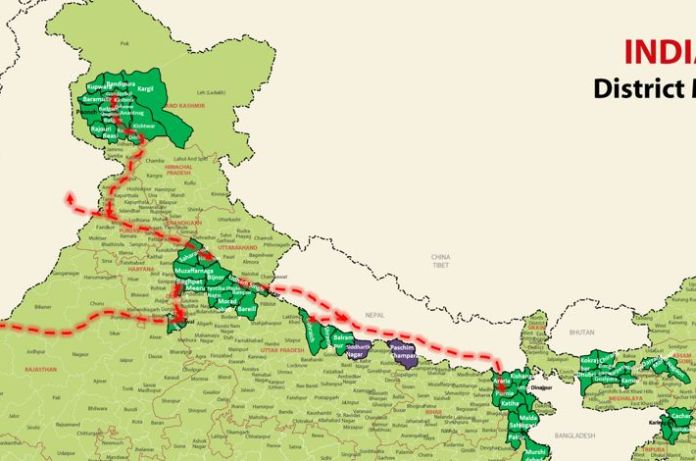
Here are the sections of districts in Bihar, West Bengal and Assam
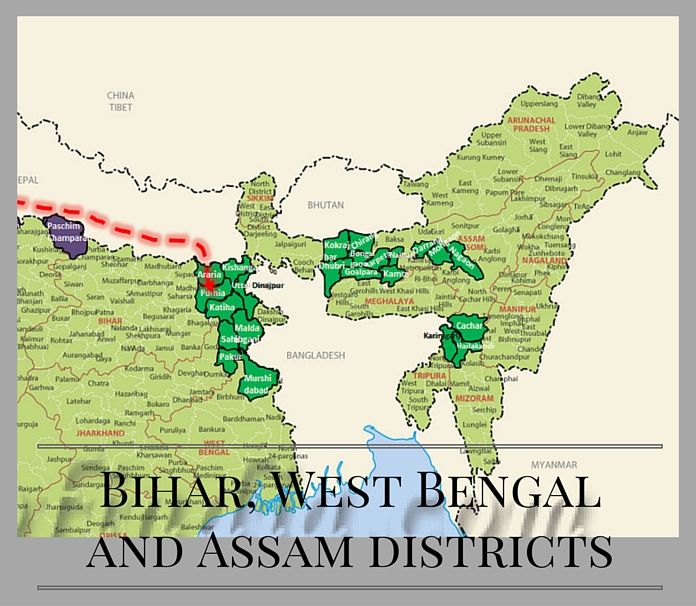
Here are the sections of districts in UP, Jammu and Rajasthan
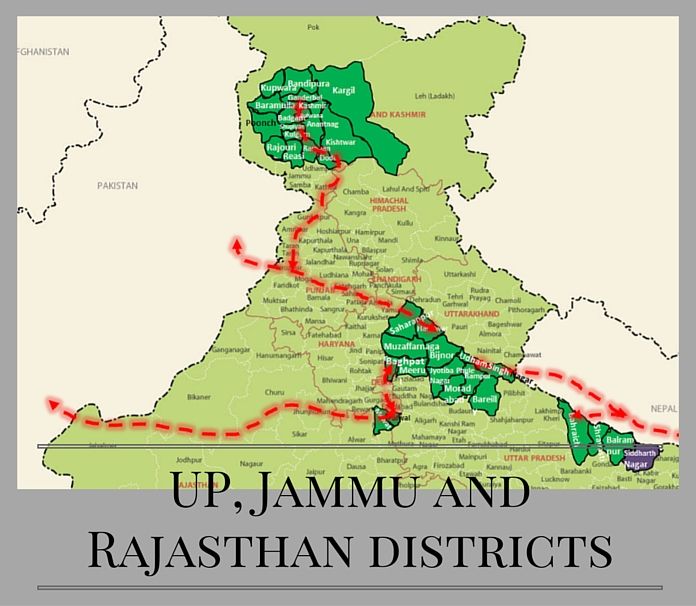
[dropcap color=”#008040″ boxed=”yes” boxed_radius=”8px” class=”” id=””]O[/dropcap]bserve now that the regions colored in green provide a corridor, from the Bangladesh border, right up to Nepal border. This corridor runs from Murshidabad-Malda, through Dinajpur and Purnia into Nepal. Nepal, being lost to Chinese and Pakistani influence by India, will constitute a long and safe corridor to from the border of Bihar, to the border of Uttar Pradesh. Here it crosses back into India along the Bahraich-Shravasti-Balrampur border, where the Muslim population is high and then has to cross a short strip of Hindu dominated territory in Kheri and Pilbhit, or it can cross farther west in the Shahid Udham Singh Nagar border, before it goes into the Muslim heavy districts of W Uttar Pradesh right up to the Yamuna and the borders of Delhi. From there, there are no Muslim heavy districts, but if the Sikh disaffection increases, there will be an easy passage across Ambala and the districts of Malwa whence it can cross into to Pakistan in Ferozepur district. An idea roughly along similar lines has been utilised by the Pakistani intelligence, in an operation codenamed `Operation Tupac’ [14] The other option would be to cross Delhi and move across the Muslim heavy Mewat into the thinly populated regions of North Rajasthan and then into Pakistan, crossing the Bikaner-Jaisalmer border. A third use of this corridor is establish an alternate route into Kashmir from the east and within India itself. This route, too, is contingent on the Sikh disaffection increasing with India. The route crosses into Ambala from Saharanpur, makes its way into Punjabi Malwa and north via the Doab or Majha into Muslim dominated regions of Doda and further north into Kashmir valley.
Thus, the religious demography is changing consistent with the vision of the Mughalistan corridor.
Section B.3: Take Home Message 3 – Strategic blockades
Many of the districts marked green in the maps presented in Section B.2 are strategically located, especially in Bihar-Jharkhand-Bengal and West Assam. We now explain the significance of these.
First note that the districts of Western Assam marked in green can be used as a strategic barrage to cut off Indian access from Northern Bengal into central and upper Assam, with the barrage stretching from the Bangladesh border of Dhubri and Goalpara northwards via Kokrajhar and Chirang to the Bhutan border. A critical mass of hostile populace in this eastern strategic barrage can be utilized for subversive activities that can isolate Northern Bengal from the North East and render the North East totally indefensible during a war.
Second, the districts of Purnia and Santhal Parganas, marked in green may be used as a strategic barrage to disconnect upper and central Ganga valley from the Bengal. The strategic barrage runs from Kishanganj on the Nepal border to Dinajpur, Malda and Murshidabad on the Bangladesh border, all marked in green. Historically, the Teliagarhi fortress (in today’s Muslim dominated area of Santhal Parganas in this region) was the key to Mughal control of Bengal and more than once in history, has proved vital, including in Mughal troubles with the British pp. 36-38, [5]. Similarly, during the Ghadar revolt of 1915, the revolutionaries had planned to blow up the railway bridge near Rajmahal (near the same Teliagarhi fortress) to cut off Bengal from reinforcements in the upper Gangetic valley p. 122, [22]. This is because a major railway line from the upper and central Ganga valley to Bengal, runs in this region, via Katihar (in Muslim dominated old Purnia) and Malda, before turning south towards Kolkata. This can be seen from the railway map below, where Sahebganj and Katihar have been marked in green consistent with the color code of the maps in Section B.2. The railways running into Assam also go the same route, before turning north into Dinajpur, following the Bangladesh border into Assam. Despite the presence of other railway lines linking the upper Ganga valley with Bengal, this railway line still constitutes the major workhorse line that transports troops and supplies (as it used to during the British times).
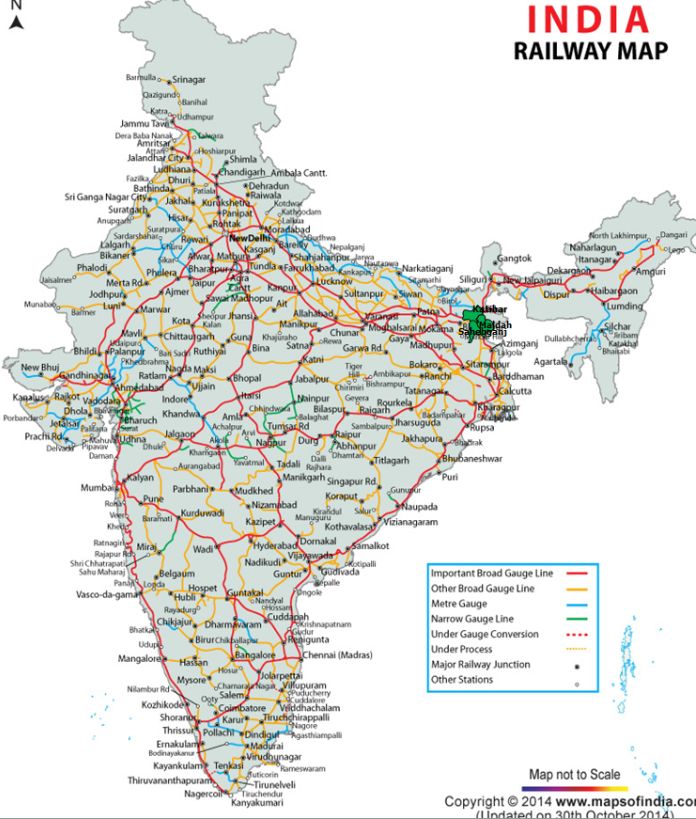
Consequently, it may be seen that Sahebganj-Katihar region is vital for our control of the railways into both Bengal and the North East. This is precisely why a hostile critical mass in this region can cut off access to not only Bengal, but also North-East India, including Assam, particularly during any future conflicts in the north east or even disturbances in Bengal or the North East.
Further, the major Hindu pilgrimage of Deoghar (the jyotirlinga of Baidyanath) is located in Santhal Pargana, just west of Muslim dominated Teliagarhi, so a Baidyanath Yatra from Bengal may easily become like the Amarnath yatra – the choice target of Islamists, operating from the safe Muslim hinterlands of Katihar and Sahebganj.
So the demographic shifts are again occurring along regions of enormous strategic importance.
Section B.4: Take Home Message 4: Delhi is Vulnerable
The West Uttar Pradesh and Mewat Muslim belts threaten Delhi from the north-east and the south-west in a pincer, with Mewat about 90 kilometres away and Baghpat about 50 kilometres. To see this, stare at the tehsils marked in green in the map below, they are in the Mewat region, and all have more than 1/3 Muslims right now (except Lachmangarh). Next, stare at the districts marked in purple, they are in Western Uttar Pradesh and all of these will be Muslim majority or close in 50 years. The Hindu percentage in both sets of marked regions are decreasing rapidly. Note their proximity to the large cities, commercial and political hubs, Alwar, Gurgaon, Bharatpur, Faridabad and Delhi. We provide the religious demography statistics of Tehsils 1-9 (of Mewat) below, and have provided the statistics for those of Western Uttar Pradesh (Meerut, Baghpat Saharanpur and Muzaffarnagar) in [8].
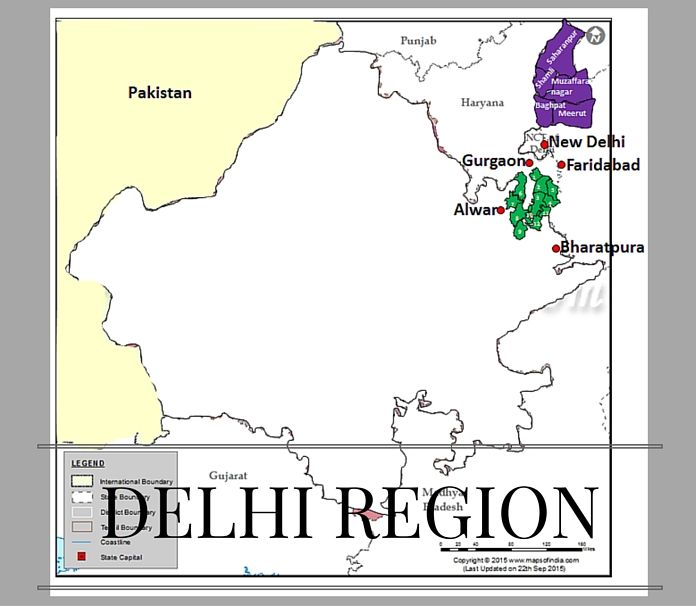
The Tehsils 1-9 (of Mewat are in the South and South-West of Delhi, and the districts of Meerut, Baghpat Saharanpur and Muzaffarnagar are just north of Delhi. So Delhi will practically be surrounded on all sides by heavy Muslim regions in the next fifty years. The recent Muzaffarnagar riots just north of Delhi, and the rising crime graph in Mewat [20] show just how vulnerable the city already is.
We now focus on the religious demography of Tehsils, 1-9 in the entire Mewat region which spans 4 districts – Mewat, parts of Palwal, parts of Alwar and parts of Bharatpur districts. The historical Mewat region used to consist of the Mewat district, Hathin tehsil of Palwal, Tijara, Kishangarh Bas, Ramgarh and Lachhmangar, in Alwar, and Nagar, Kaman and Pahari tehsils of Bharatpur district. This North eastern corner of the Aravallis is the traditional haunt of the Meo Muslims and it has spanned the border of Rajasthan and Haryana along the Aravallis. Almost all of the Muslim population of the Gurgaon (aggregated) district can be found in the Mewat region. The current Mewat district has more than 70% Muslims and the Muslims in the region have been growing between 40 and 60% every decade, despite considerable emigration. The Total Fertility Rate of Mewat district (which is predominantly Muslim) was 4.9 [3]. The growth of the Muslims in the four tehsils of Taoru, Nuh, Ferozepur Jhirka and Punahana of Mewat district, the Hathin tehsil of Palwal and parts of Alwar and Bharatpur districts is exceptionally high as we show in the table below. For the sake of comparison, we have included the Muslim and Hindu growth rates in all the tehsils of Mewat region:
| Table 4: The percentages of the actual populations of the Hindus in 2001 and 2011 are shown in columns 3 and 4 respectively, and the growth rates of the Hindus and Muslims in percentage terms are shown in columns 5 and 6 respectively are shown in the table | |||||
| Tehsil | District | Hindus in 2001 | Hindus in 2011 | Hindu Growth 2001-2011 | Muslim Growth 2001-2011 |
| Taoru | Mewat | 50.82 | 42.2 | 9.76 | 55.19 |
| Nuh | Mewat | 28.82 | 23.21 | 8.19 | 45.69 |
| Ferozepur-Jhirka | Mewat | 17.44 | 14.4 | 19.36 | 44.39 |
| Punahana | Mewat | 14.76 | 12.48 | 19.35 | 44.71 |
| Hathin | Palwal | 45.62 | 40.59 | 17.2 | 43.2 |
| Tijara | Alwar | 64.58 | 62.02 | 35.91 | 51.51 |
| Kishangarh-Bas | Alwar | 70.37 | 66.37 | 17.54 | 39.58 |
| Ramgarh | Alwar | 65.81 | 61.73 | 18.79 | 42.02 |
| Lachmangarh | Alwar | 78.11 | 75.02 | 14.81 | 35.84 |
| Pahari | Bharatpur | 31.62 | 26.96 | 14.99 | 43.56 |
| Kaman | Bharatpur | 59.94 | 54.93 | 18.51 | 45.24 |
| Nagar | Bharatpur | 68.41 | 64.08 | 15.82 | 40.8 |
[dropcap color=”#008040″ boxed=”yes” boxed_radius=”8px” class=”” id=””]F[/dropcap]rom the above growth rate disparity, one may easily see that the Meo Muslim community is rapidly growing and so fast that Hindus are being turned into the minority in so many tehsils, not only in the present Mewat district, but also in many neighboring districts. The Mewat region is therefore demographically expanding in all directions. The Hindu percentage fell 2.1% in Bharatpur district, and 2.28% in Alwar district between 2001 and 2011 – an unprecedented fall for a district where Hindus are >80%. The same trend is visible in the southernmost tehsil of Gurgaon district, Sohna (lost 2%), the western most tehsil of Mathura district, Chhata (lost 2%). Further, perhaps due to spread of Muslims from Muzaffarnagar, Panipat district in Haryana lost 1.5% Hindus. Sohna, Panipat and Chhata are overwhelmingly Hindu at the moment, but yet, are losing Hindus at a surprisingly high rate; the rate of loss is particularly surprising given how high the Hindu percentage is in these. The trend is set to accelerate in the coming years, with falling Hindu fertility rate and a surprisingly high Meo Muslim fertility rate..
With the sharply falling Hindu percentages, not only in Muslim heavy Meerut, Muzaffarnagar, Baghpat and Mewat, but also in adjoining tehsils of Palwal, Gurgaon, Panipat and Mathura, Delhi and the commercial hubs of Guegaon and Faridabad are not only caught in a pincer from the north east and south west, but they are being strategically encircled. The vulnerability of these constitutes a serious physical threat to the poor there (the rich are rarely affected by riots), and an equally potent threat for regions in the periphery of India. The Indian state has a long tradition of creating a hierarchy among regions depending on their political and commercial significance. This was seen in how Hindu majority districts (eg, Khulna) were traded off during partition to retain Muslim majority ones (eg, Murshidabad) of greater perceived commercial value (To keep Kolkata port open, it was necessary that India should control the headwaters of the Bhagirathi, near Murshidabad; Hindu majority Khulna, in contrast, was a major rice growing area, but little else) pp. 45-46, [25]; in how Assam and the North East were left to the mercy of the Chinese army in 1962 (Nehru’s famous speech bade farewell to the people of Assam, telling them to fight on as they could while he and his people fled, p. 107, [26]) ; in how almost the entire North East was allowed to be converted to Christianity without a semblance of resistance. Thus the vulnerability of the political and commercial hubs may well serve as a bargaining chip in the hands of the subversive elements to compel Delhi to concede their other demands, including compromise of Hindu interests in peripheral areas of perceived lower commercial import like what remains of North East, Assam, West Bengal, Kerala, Andhra Pradesh, Tamil Nadu, Odisha, Punjab, Jammu and Ladakh.
Section B.5: Take Home Message 5: Political indifference
[dropcap color=”#008040″ boxed=”yes” boxed_radius=”8px” class=”” id=””]I[/dropcap]t has been proposed in Right Wing (RW) circles that the Congress and other secular parties patronise the Islamists and the evangelists and other proselytisers, but the BJP opposes them. However, Jharkhand stands as a strong counter-example to that theory. Of the 11 years that passed between the formation of Jharkhand and the 2011 census, BJP had been in power for over 7 years. The Christian population of Santhal Parganas increased by 3.5 times between 1991 and 2011, and nearly doubled between 2001 and 2011. However, the BJP has taken no steps to check the rapid growth of Christianity (despite its avowed opposition to proselytisation). Since 2014, the BJP has been in power again in Jharkhand, and has nevertheless, taken no steps to check the growth of Christians. A law against fraudulent conversions has been in vogue in Gujarat since early 2000s, but no such move is proposed in Jharkhand. Enacting such a law would inevitably lead to a significant backlash due to the wide reach of the missionary lobbies and their connections to human rights groups, global commercial interests, journalists and politicians in India, and substantial political capital would be necessary to counter the backlash. It is interesting that the BJP would expend its political capital for Gujarat, but won’t risk the same for Jharkhand. The reason for the BJP not risking political capital in taking on the church is for people to speculate, but facts of the matter are as follows. In 2006, proposal for anti-conversion law had been proposed by RSS-backed BJP, but the latter chickened out when JDU threatened to withdraw support and topple the government. Church websites celebrated this news openly [4]. Although VHP has started raising demands for the anti-conversion law again 2013 onward, yet the so-called Hindu nationalist BJP hasn’t done anything on that front since regaining power in 2014. In contrast, in the 3 decades from 1961 and 1991, the Christian population just grew to slightly more than double its population (and at nearly the same rate as the Hindu tribal population).
To be continued…
Note:
1. Text in Blue points to additional data on the topic.
References
[1] Sankar Ghosh, “Jawaharlal Nehru: A Biography”,
[2] LSS O’Malley, “Purnea District Gazetteer”, 1908
[3] CZ Guilmoto and I. Rajan, “Fertility at District Levels in India: Lessons from the 2011 census”, http://www.ceped.org/IMG/pdf/ceped_wp30.pdf
[4] “Church Happy as Conversion Bill Threatens State Government”, http://www.ucanews.com/story-archive/?post_name=/2006/08/30/church-happy-as-conversion-bill-threatens-jharkhand-states-coalition-government&post_id=27867
[5] National Geographic Journal of India 16.112
[6] K. K. Sinha, Excavation at sravasti, 1967
[7] Minhaj -US -Siraj, “Tabakat i nasiri, Trans. History of India as told by its own historians volume 2”)
[8] Shanmukh, Dikgaj and Saswati Sarkar, “Western Uttar Pradesh and Southern Uttarakhand: Muslim Majority by 2061?” http://www.dailyo.in/politics/population-muslims-muzaffarnagar-uttarakhand-shamli-western-uttar-pradesh-hindus-sikh-demography/story/1/10631.html
[9] Shanmukh, Dikgaj and Saswati Sarkar, “A Demographic Warning for West Bengal”, https://www.myind.net/demographic-warning-west-bengal
[10] Shanmukh, Saswati Sarkar, Dikgaj and Aparna, “Will Assam be Muslim Majority in the next 40 years?” http://indiafacts.org/will-assam-muslim-majority-next-40-years/
[11] Shanmukh, Saswati Sarkar, Dikgaj, and Aparna, “Kerala and South Tamil Nadu – A Case of Hindu Fade out” http://indiafacts.org/kerala-south-tamil-nadu-case-hindu-fade/
[12] Shanmukh, Vikram, Aparna, Saswati Sarkar, and Dikgaj, “The Demographic expansion of Kashmir and the shrinking of Jammu and Ladakh” https://www.myind.net/demographic-expansion-kashmir-and-shrinking-jammu-and-ladakh#.V3UOVSF0xwc.twitter
[13] LSL O’Malley, “District Gazetteer of Santal Parganas”, 1910
[14] Sean Winchell, “Pakistan’s ISI: The Invisible Government”, International Journal of Intelligence and CounterIntelligence, Vol. 16(3), http://www.tandfonline.com/doi/abs/10.1080/713830449
[15] HR Neville, “District Gazetteer of Gonda”, 1905
[16] HR Neville, “District Gazetteer of Bahraich”, 1903
[17] Shail Mayaram, “Perspectives on Violence and Othering in India”
[18] Gurgaon District Gazetteer, 1883.
[19] NB Khare, “My Autobiography, or my Political Memoirs”
[20] Gangs of Mewat http://www.hindustantimes.com/india/in-mewat-govt-s-indifference-and-neglect-a-bigger-reality-than-crime/story-FaXR9hW7KNlqvSRpn0iAUL.html
[21] Partha Ghosh, “Migrants, Refugees and the Stateless”
[22] Lord Rowlatt Committee, “Seditions Committee Report”
[23] Kazi Fahmida Farzana, “The Neglected Stateless Bihari community in Bangladesh : victims of political and diplomatic onslaught” Journal of Humanities and Social Sciences, Vol 2,Issue 1, 2008
[24] Encyclopaedia Britannica “Nehru-Liaqat Pact or Delhi Pact”, 1950
[25] Joya Chatterjee, “The Spoils of Partition”
[26] Braja Bihari Kumara, “Illegal Migration from Bangladesh”
- How we computed Hindu, Muslim & Christian growth – Part 3 of Hotspots series - July 30, 2016
- Hindu population shrinking – Part 2 of Hotspots series - July 29, 2016
- Hotspots in the Hindi Belt, Part 1 – the Northern Arc - July 26, 2016



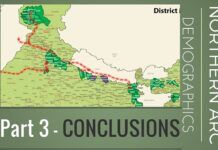







We should understand that Muslims are approaching 20% of the population in the youngest generation (0-4 age cohort).
We Hindus need to COUNTERBREED 4-5 children, following the example of Orthodox Jews in Israel. Let’s say you have a group of 10 million Orthodox Hindus who produce 6 children each for 4 generations (100 years).
In 100 years (2220), we will have an extra 10 million * 3^4 = 810 million extra Hindus by 2220.
This would defeat Muslim population jihad.
I am happy that you brought these things to light. I really appreciate it. What is missing though is the solution.
All this doom and gloom( and i am not being sarcastic) is enough to give a concerned Hindu like me high B.P. and insomnia.
So, should i just give up?? Castrate myself and commit suicide because its a lost cause anyways for my would be descendants???
I really like you guys doing this, but i think you guys come off as if you’re writing the obituary of Hindu civilization. Please provide some solutions. I know that understanding the problem is an important part of the solution but do please tell us what to do. Tell me what to do.??
The only solution i can think of is massive cleansing of muzzie filth by force. I am ready for that. For the sacrifices and pain that comes along with that too.
Please understand that i am not making fun of you guys but i am genuinely concerned about solutions.
The way you guys put forward this material it just comes off as doom and gloom that most people are put off by.
Based on your material it just seems inevitable that hindus are going to go extinct. So might as well spare ourselves the pain and despair and commit suicide.
or Do you guys have A REAL solution.???
I am sorry for the rant but I’m upset by recent happenings and am concerned
Who is stopping Hindus to produce 10 babies..question is will we do it? Cause only then I am hoping government will put cap on the child births.